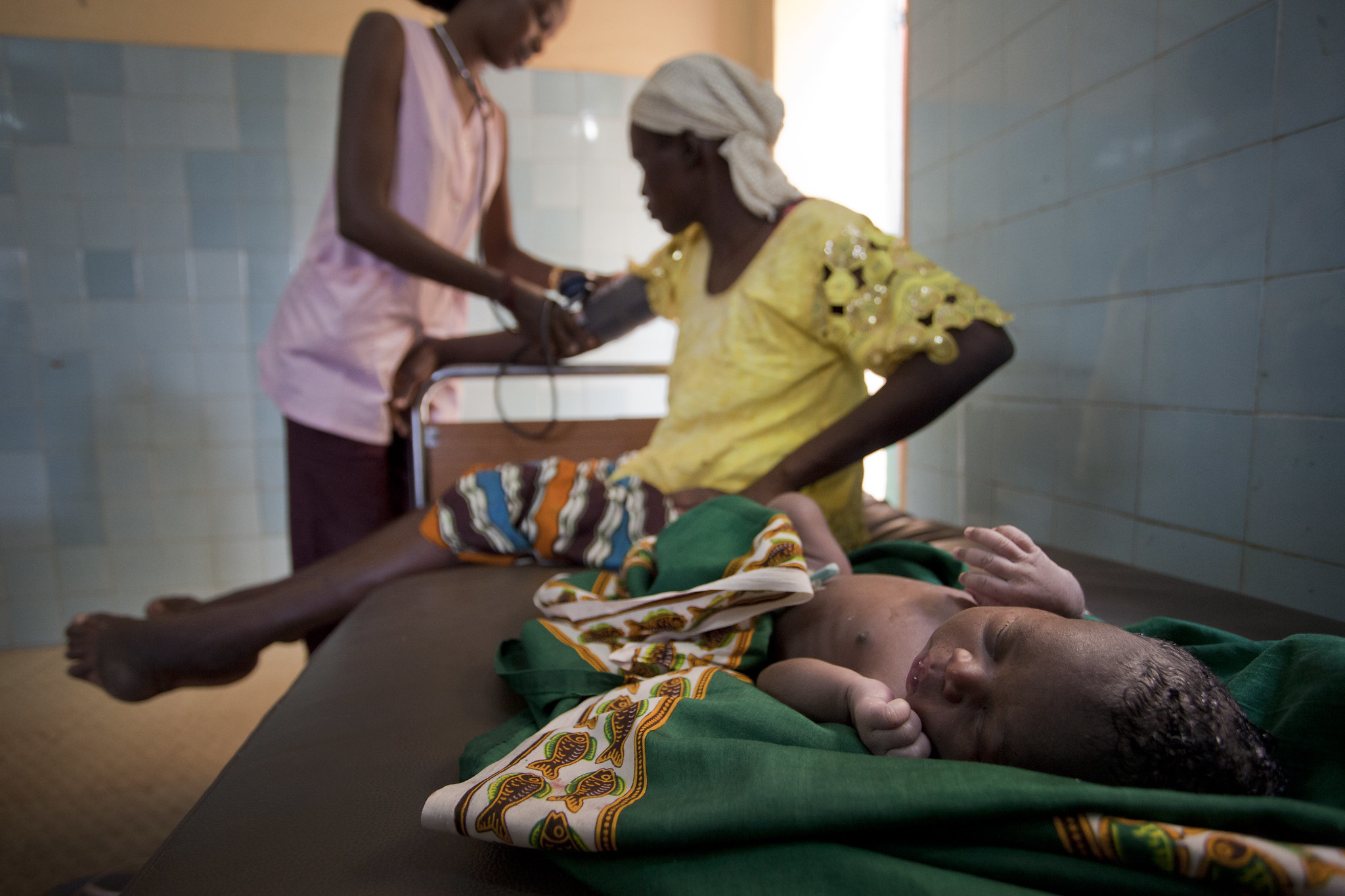Intermittent preventive treatment in pregnancy (IPTp) and SP-resistance-associated mutations Study Group
Intermittent preventive treatment in pregnancy (IPTp) and SP-resistance-associated mutations Study Group

The overall aim of the IPTp and SP-resistance-associated mutations Study Group is to quantify how parasites with the sextuple mutant pfdhps and pfdhfr haplotype* modify the effect of IPTp on maternal and infant outcomes.
A systematic review has been carried out. The call for contributors of individual participant data is open.
Intermittent preventive treatment in pregnant women (IPTp) with sulphadoxine-pyrimethamine (SP) to prevent P. falciparum malaria is recommended in areas of sub-Saharan Africa with moderate to high transmission intensity. Parasite mutations conferring resistance to SP reduce the impact of IPTp, but a recent meta-analysis found that IPTp still significantly reduces the risk of low birth weight even in areas with high levels of the pfdhfr and pfdhps quintuple mutant haplotype (1). However, this ecological analysis also showed that IPTp appears to have no significant protective effect in areas where parasites commonly carry an additional mutation, pfdhps A581G (sextuple mutant haplotype).
Furthermore, several clinical studies have shown that the efficacy of SP is compromised in individual women infected with these sextuple mutants (2-5). One of these studies suggested that IPTp could even worsen outcomes in women infected with A581G mutant parasites, with IPTp-treated women having higher parasitaemia than those not receiving IPTp (2,3,6), but this result was not replicated in other studies. However, all of these individual studies suffered from small sample sizes, especially in the sub-group of women infected with the A581G mutant parasites (maximum of 33 women per study, Table 1), and the clinical implications of the A581G mutations remain unclear.
Pooling individual participant data from these studies would increase the number of infections with the sextuple mutant and allow the assessment of their impact on the effectiveness of IPTp with SP at an individual level while adjusting for potential confounders and/or stratifying by potential effect modifiers.
Overall aim: To quantify how parasites with the SP resistance-associated sextuple mutant haplotype* modify the effect of IPTp on maternal and infant outcomes.
Specific objectives
1. To estimate the effect of each additional dose of IPTp on maternal and infant outcomes such as low birth weight (see below for full list of outcomes) in women infected with the sextuple mutant parasites versus women infected with other parasite genotypes.
2. To estimate the efficacy of IPTp in preventing infection with different parasite genotypes.
* defined as carrying these mutations: pfdhfr 51I, 59R, 108N and pfdhps 437G, 540E, 581G
Inclusion criteria for studies
Studies will be included which assess:
The number of SP courses received for IPTp, including none
The parasite pfdhps genotype amongst infected women during the study and found at least one participant infected with parasites with the sextuple mutant.
At least one of the following maternal or infant outcomes:
- Birth weight
- Parasitaemia (placental or peripheral)
- Haemoglobin concentration in mothers or babies
- Mean gestational age or pre-term delivery
- Pregnancy loss (stillbirth or miscarriage)
- Placental histology
Amongst infected women, we will look at the difference in outcomes (e.g. mean birthweight) associated with each additional dose of SP by parasite genotype (sextuple mutant versus parasites with fewer mutations). Amongst all women, we will explore the change in prevalence of infection with sextuple mutants per each additional IPTp dose, compared with the same outcome for other parasite genotypes. All studies identified so far measure outcomes at the time of delivery. Two also assessed women at earlier time points (for peripheral parasitaemia, anaemia).
We will analyse the effect of each additional dose of IPTp on the outcomes above by log binomial or linear regression, as appropriate (e.g. LBW by log binomial regression, log parasitaemia by linear regression). We will explore whether each additional dose has a linear or non-linear effect on outcomes. Given the small number of studies, we will assume fixed study effects on outcomes and on IPTp impact. We aim to explore (where data are available) the effects of:
- Individual level
- Gravidity
- Age
- Time since SP dose
- Number of doses received
- Socioeconomic status
- Access to healthcare
- Use of ITN
- Study level
- Local malaria transmission intensity (using Malaria Atlas Project estimates)
- Quality assessment
- Time period
After upload to the WWARN Data Repository, data sets will be standardised according to the WWARN Clinical Data Management and Statistical Analysis Plan and all primary data sets will be pooled into a single database of quality-assured individual patient data.
A detailed statistical analysis plan will be developed prior to commencing the analysis and will be shared with all contributors.
The (IPTp) and SP-resistance-associated mutations Study Group comprises participating investigators who contribute relevant data sets to the pooled analysis. Data sets will remain the property of the investigator and will not be shared without their consent. Dr Lucy Okell will oversee the statistical analyses. The Study Group collectively makes decisions with respect to including additional studies, and plans for publication. Participating investigators will be recognized in publication as individual authors. The Study Group will assign a Writing Committee to coordinate activities including data analysis, and drafting of publications and reports for complete group review. The Writing Committee will comprise a group of interested investigators undertaking the data analysis and preparation of the manuscript. Authors will be recognised according to the ICMJE guidelines and the WWARN publication policy.
For further information, please contact Lucy Okell at: l.okell@imperial.ac.uk or Caroline Osoro at 25665073@sun.ac.za
1. van Eijk AM, Larsen DA, Kayentao K, et al. Effect of Plasmodium falciparum sulfadoxine-pyrimethamine resistance on the effectiveness of intermittent preventive therapy for malaria in pregnancy in Africa: a systematic review and meta-analysis. Lancet Infect Dis 2019; 19(5): 546-56.
2. Harrington WE, Mutabingwa TK, Kabyemela E, Fried M, Duffy PE. Intermittent treatment to prevent pregnancy malaria does not confer benefit in an area of widespread drug resistance. Clin Infect Dis 2011; 53(3): 224-30.
3. Harrington WE, Mutabingwa TK, Muehlenbachs A, et al. Competitive facilitation of drug-resistant Plasmodium falciparum malaria parasites in pregnant women who receive preventive treatment. Proc Natl Acad Sci U S A 2009; 106(22): 9027-32.
4. Gutman J, Kalilani L, Taylor S, et al. The A581G Mutation in the Gene Encoding Plasmodium falciparum Dihydropteroate Synthetase Reduces the Effectiveness of Sulfadoxine-Pyrimethamine Preventive Therapy in Malawian Pregnant Women. J Infect Dis 2015; 211(12): 1997-2005.
5. Minja DT, Schmiegelow C, Mmbando B, et al. Plasmodium falciparum mutant haplotype infection during pregnancy associated with reduced birthweight, Tanzania. Emerg Infect Dis 2013; 19(9).
6. Harrington WE, Morrison R, Fried M, Duffy PE. Intermittent preventive treatment in pregnant women is associated with increased risk of severe malaria in their offspring. PLoS One 2013; 8(2): e56183.



